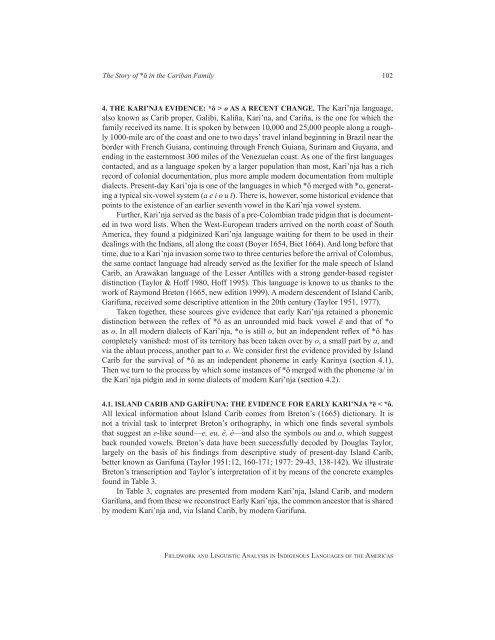Fieldwork and Linguistic Analysis in Indigenous ... - ScholarSpace
Fieldwork and Linguistic Analysis in Indigenous ... - ScholarSpace
Fieldwork and Linguistic Analysis in Indigenous ... - ScholarSpace
You also want an ePaper? Increase the reach of your titles
YUMPU automatically turns print PDFs into web optimized ePapers that Google loves.
The Story of *ȏ <strong>in</strong> the Cariban Family 102<br />
4. THE KARI’NJA EVIDENCE: *ô > o AS A RECENT CHANGE. The Kari’nja language,<br />
also known as Carib proper, Galibi, Kaliña, Kari’na, <strong>and</strong> Cariña, is the one for which the<br />
family received its name. It is spoken by between 10,000 <strong>and</strong> 25,000 people along a roughly<br />
1000-mile arc of the coast <strong>and</strong> one to two days’ travel <strong>in</strong>l<strong>and</strong> beg<strong>in</strong>n<strong>in</strong>g <strong>in</strong> Brazil near the<br />
border with French Guiana, cont<strong>in</strong>u<strong>in</strong>g through French Guiana, Sur<strong>in</strong>am <strong>and</strong> Guyana, <strong>and</strong><br />
end<strong>in</strong>g <strong>in</strong> the easternmost 300 miles of the Venezuelan coast. As one of the first languages<br />
contacted, <strong>and</strong> as a language spoken by a larger population than most, Kari’nja has a rich<br />
record of colonial documentation, plus more ample modern documentation from multiple<br />
dialects. Present-day Kari’nja is one of the languages <strong>in</strong> which *ô merged with *o, generat<strong>in</strong>g<br />
a typical six-vowel system (a e i o u ï). There is, however, some historical evidence that<br />
po<strong>in</strong>ts to the existence of an earlier seventh vowel <strong>in</strong> the Kari’nja vowel system.<br />
Further, Kari’nja served as the basis of a pre-Colombian trade pidg<strong>in</strong> that is documented<br />
<strong>in</strong> two word lists. When the West-European traders arrived on the north coast of South<br />
America, they found a pidg<strong>in</strong>ized Kari’nja language wait<strong>in</strong>g for them to be used <strong>in</strong> their<br />
deal<strong>in</strong>gs with the Indians, all along the coast (Boyer 1654, Biet 1664). And long before that<br />
time, due to a Kari’nja <strong>in</strong>vasion some two to three centuries before the arrival of Colombus,<br />
the same contact language had already served as the lexifier for the male speech of Isl<strong>and</strong><br />
Carib, an Arawakan language of the Lesser Antilles with a strong gender-based register<br />
dist<strong>in</strong>ction (Taylor & Hoff 1980, Hoff 1995). This language is known to us thanks to the<br />
work of Raymond Breton (1665, new edition 1999). A modern descendent of Isl<strong>and</strong> Carib,<br />
Garifuna, received some descriptive attention <strong>in</strong> the 20th century (Taylor 1951, 1977).<br />
Taken together, these sources give evidence that early Kari’nja reta<strong>in</strong>ed a phonemic<br />
dist<strong>in</strong>ction between the reflex of *ô as an unrounded mid back vowel ë <strong>and</strong> that of *o<br />
as o. In all modern dialects of Kari’nja, *o is still o, but an <strong>in</strong>dependent reflex of *ô has<br />
completely vanished: most of its territory has been taken over by o, a small part by a, <strong>and</strong><br />
via the ablaut process, another part to e. We consider first the evidence provided by Isl<strong>and</strong><br />
Carib for the survival of *ô as an <strong>in</strong>dependent phoneme <strong>in</strong> early Kar<strong>in</strong>ya (section 4.1).<br />
Then we turn to the process by which some <strong>in</strong>stances of *ô merged with the phoneme /a/ <strong>in</strong><br />
the Kari’nja pidg<strong>in</strong> <strong>and</strong> <strong>in</strong> some dialects of modern Kari’nja (section 4.2).<br />
4.1. ISLAND CARIB AND GARÍFUNA: THE EVIDENCE FOR EARLY KARI’NJA *ë < *ô.<br />
All lexical <strong>in</strong>formation about Isl<strong>and</strong> Carib comes from Breton’s (1665) dictionary. It is<br />
not a trivial task to <strong>in</strong>terpret Breton’s orthography, <strong>in</strong> which one f<strong>in</strong>ds several symbols<br />
that suggest an e-like sound—e, eu, ê, é—<strong>and</strong> also the symbols ou <strong>and</strong> o, which suggest<br />
back rounded vowels. Breton’s data have been successfully decoded by Douglas Taylor,<br />
largely on the basis of his f<strong>in</strong>d<strong>in</strong>gs from descriptive study of present-day Isl<strong>and</strong> Carib,<br />
better known as Garifuna (Taylor 1951:12, 160-171; 1977: 29-43, 138-142). We illustrate<br />
Breton’s transcription <strong>and</strong> Taylor’s <strong>in</strong>terpretation of it by means of the concrete examples<br />
found <strong>in</strong> Table 3.<br />
In Table 3, cognates are presented from modern Kari’nja, Isl<strong>and</strong> Carib, <strong>and</strong> modern<br />
Garifuna, <strong>and</strong> from these we reconstruct Early Kari’nja, the common ancestor that is shared<br />
by modern Kari’nja <strong>and</strong>, via Isl<strong>and</strong> Carib, by modern Garifuna.<br />
fieldwork <strong>and</strong> l<strong>in</strong>guistic analysis <strong>in</strong> <strong>in</strong>digenous languages of the americas

















